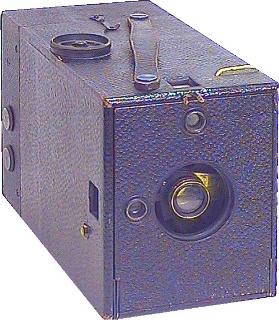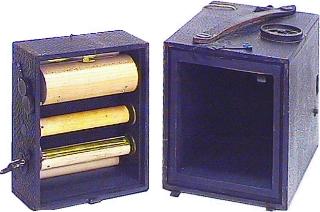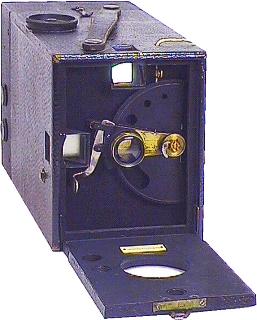No. 4 Kodak Junior
 |
Film Size: Darkroom-loaded celluloid roll film,
4"x5" image, 60 or 100 exposures per roll Shutter: String-set sector shutter Lens: Bausch & Lomb 6½" Universal, 4 wheel-set apertures, rack-and-pinion focus Dates: 1889-1897 Original List Price: $50.00 Condition: 8+ |
| Made only in the No. 3 (3¼x4¼) and No. 4 (4x5) sizes, the Kodak Junior
camera was a major improvement over the original line of Kodak cameras. Kodak Juniors are
historically important because they were the very first Kodaks made that allowed the user
to handle film. Prior to this, all Kodaks all had to be returned to Rochester for film
processing and reloading.
The Kodak Juniors were also available with a glass plate holder instead of the rollfilm
holder. These models were known as Junior Glass Plate Kodaks.
The large wheel on the top of the camera is the rack-and-pinion focusing mechanism.
This mechanism moved the entire box to which the lens and shutter were mounted fore
and aft inside the outer camera case. |
|
 The Kodak Juniors were fitted with a variation of the Walker rollfilm
holder, as shown at the right, which allowed the owner to remove and process the film and
reload the camera. Film unloading and loading had to be done in a darkroom, however, since
the celluloid film did not yet have an opaque leader or backing. That invention was not to
come along until 1892, and did not appear on a Kodak camera until 1895.
The Kodak Juniors were fitted with a variation of the Walker rollfilm
holder, as shown at the right, which allowed the owner to remove and process the film and
reload the camera. Film unloading and loading had to be done in a darkroom, however, since
the celluloid film did not yet have an opaque leader or backing. That invention was not to
come along until 1892, and did not appear on a Kodak camera until 1895.  This photo
shows the front of the camera with the hinged faceplate opened, exposing the unique
string-set shutter mechanism and the aperture wheel. Pulling the string cocked the shutter
mechanism, which is then tripped by pressing the button on the side near the reflecting
viewfinder. The faceplate had to be opened like this to select the shutter aperture.
This photo
shows the front of the camera with the hinged faceplate opened, exposing the unique
string-set shutter mechanism and the aperture wheel. Pulling the string cocked the shutter
mechanism, which is then tripped by pressing the button on the side near the reflecting
viewfinder. The faceplate had to be opened like this to select the shutter aperture.